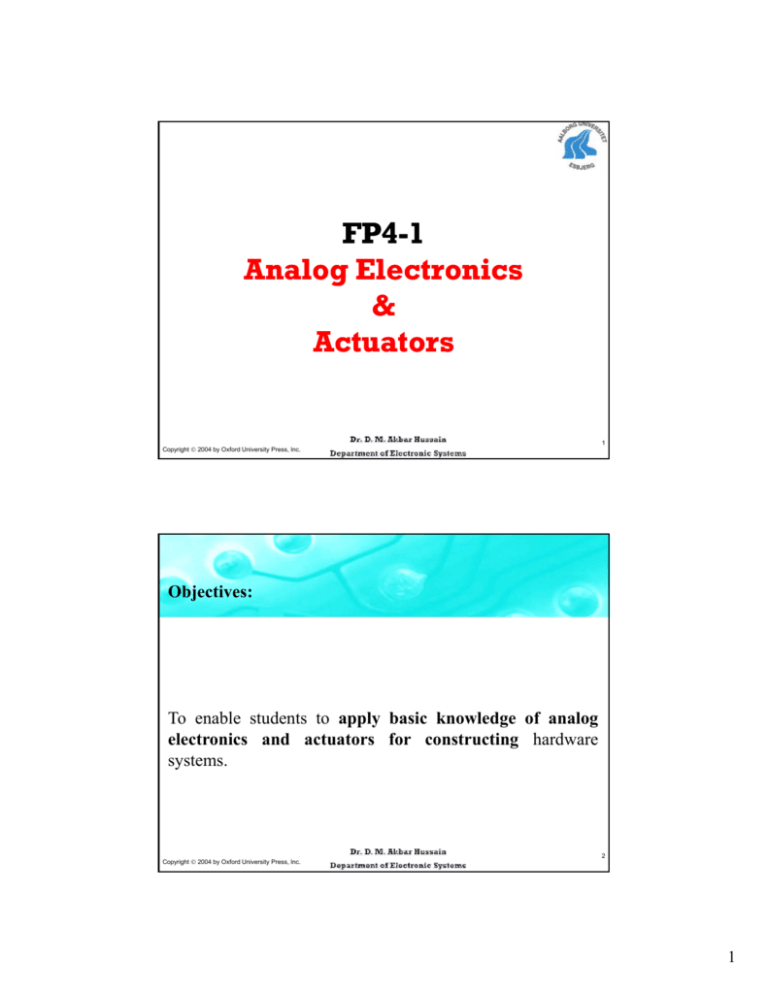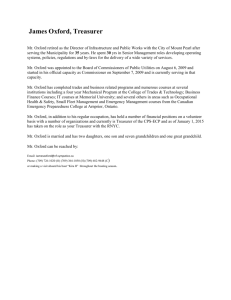
FP4-1
FP4Analog Electronics
&
Actuators
Copyright © 2004 by Oxford University Press, Inc.
1
Objectives:
To enable students to apply basic knowledge of analog
electronics and actuators for constructing hardware
systems
systems.
Copyright © 2004 by Oxford University Press, Inc.
2
1
Contents:
Analog Electronics
o Diodes,, PN-junction,
j
, small-signal
g model
o Rectifiers, filtering and stabilization
o Practical operational amplifier circuits, common-mode rejection ratio, slew-rate
o Bipolar junction transistor basics, DC-analysis, signal amplification, small-signal model
o Properties of the transistor
o Frequency response of the transistor amplifier
o MOSFET transistor
Electrical Actuators
o Electromechanical energy conversion. General principle, Work, forces, torque, efficiency
etc. for electric machines.
o DC-motors. DC-machine construction, characteristics, dynamic models and applications.
Motor drivers
Copyright © 2004 by Oxford University Press, Inc.
3
Course Web Page
Contents
Schedule
Slides
Useful Links
Any
An other Matter & Related Material
Copyright © 2004 by Oxford University Press, Inc.
4
2
Microelectronic Circuits 5/e
Sedra/Smith
Sedra
/Smith
Copyright © 2004 by Oxford University Press, Inc.
Oxford University Press
Oxford New York
Auckland Bangkok Buenos Aires Cape Town Chennai
Dar es Salaam Delhi Hong Kong Istanbul Karachi Kolkata
Kuala Lumpur Madrid Melbourne Mexico City Mumbai Nairobi
São Paulo Shanghai Taipei Tokyo Toronto
Copyright © 2004 by Oxford University Press, Inc.
Published by Oxford University Press, Inc.
198 Madison Avenue, New York, New York 10016
www oup com
www.oup.com
Oxford is a registered trademark of Oxford University Press
All rights reserved. No part of this publication may be reproduced,
stored in a retrieval system, or transmitted, in any form or by any means,
electronic, mechanical, photocopying, recording, or otherwise,
without the prior permission of Oxford University Press.
ISBN 0–19–517267–1
Printing number: 9 8 7 6 5 4 3 2 1
Printed in the United States of America
Copyright © 2004 by Oxford University Press, Inc.
6
3
Diodes
Lecture # 1
7
The Ideal Diode
Copyright © 2004 by Oxford University Press, Inc.
8
4
Forward / Reversed Biased
Copyright © 2004 by Oxford University Press, Inc.
9
The Rectifier
Figure 3.3 (a) Rectifier circuit. (b) Input waveform. (c) Equivalent circuit when vI ≥ 0. (d) Equivalent circuit when vI ≤ 0. (e) Output waveform.
Copyright © 2004 by Oxford University Press, Inc.
10
5
Exercise 3.1
For the circuit (a) sketch the transfer characteristics Vo versus Vi.
Copyright © 2004 by Oxford University Press, Inc.
11
Exercise 3.2 & 3.3
For the circuit (a) sketch the waveform of VD.
Copyright © 2004 by Oxford University Press, Inc.
12
6
Example 3.1
For the circuit (a) find the fraction of the cycle during which diode conducts, peak value of the
diode current and the maximum reverse bias voltage across diode.
Copyright © 2004 by Oxford University Press, Inc.
13
Diode Logic Gates
Copyright © 2004 by Oxford University Press, Inc.
14
7
Example 3.2: Calculate V & I
ID2 = (10 – 0)/10 * 103
= 1 mA
I + 1 = (0 – (-10))/5 * 103
=2
I
= 2 – 1 = 1 mA
Copyright © 2004 by Oxford University Press, Inc.
15
Example 3.2: Calculate V & I
ID2 = (10 – 0)/5 * 103
= 2 mA
I + 2 = (0 – (-10))/10 * 103
=1
I
= 1 – 2 = -1 mA
ID2 = (10 – (-10))/15 * 103
= 1.33 mA
VB = -10 + (10 * 103 * 1.33 * 10-3)
VB = 3.3 V
Copyright © 2004 by Oxford University Press, Inc.
16
8
Exercise 3.4: Calculate V & I
2.0 mA
0V
0.0 mA
5V
0.0 mA
5V
Copyright © 2004 by Oxford University Press, Inc.
2.0 mA
0V
17
Exercise 3.4: Calculate V & I
3.0 mA
3V
Copyright © 2004 by Oxford University Press, Inc.
4.0 mA
1V
18
9
Exercise 3.5:
Calculate R, that result full scale reading when the input sine wave voltage is 20 V p-p. The meter gives
full scale reading when the average current flowing through it is 1 mA, coil has 50 ohm resistance.
(Hint: The average value of half wave rectifier is Vp/π .)
Peak to Peak
20
Copyright © 2004 by Oxford University Press, Inc.
19
Terminal Behaviour/Characteristics
Copyright © 2004 by Oxford University Press, Inc.
20
10
i-v Characteristics
Copyright © 2004 by Oxford University Press, Inc.
21
Forward Bias Region
i = I S (e v / nVT − 1)
VT =
kT
q
i ≈ I S e v / nVT
Copyright © 2004 by Oxford University Press, Inc.
22
11
Exercises: 3.6, 3.7 & 3.8
3.6: Consider a silicon diode with n = 1.5, Find the change in voltage if the current changes from 0.1 mA to 10 mA.
3.7: A silicon junction diode with n = 1 has v = 0.7 V at i=1 mA. Find the voltage drop at i=0.1 mA and i=10mA.
3.8: Using the fact that silicon diode as IS=10-14 A at 25o C and IS increases by 15 % per oC rise in temperature, find the value of
IS at 125oC.
Copyright © 2004 by Oxford University Press, Inc.
23
Reverse Bias Region
i ≈ I S e v / nVT
i ≈ −I S
Copyright © 2004 by Oxford University Press, Inc.
The reverse current is due to leakage
effects, which is proportional to the
junctions area and its dependence on
temperature, which is different from
saturation current as in this case it
doubles with every 10 degree rise in
temperature.
24
12
Exercise 3.9
If V = 1 v at 20oC, find the value of V at 40oC and at 0oC.
Copyright © 2004 by Oxford University Press, Inc.
25
Breakdown Region
Copyright © 2004 by Oxford University Press, Inc.
26
13
Modelling Forward Charcteristics
Following simple circuit used to illustrate the analysis of circuits in which the
diode is forward conducting.
Exponential Model is the most accurate, but the trouble is it is severely ?
Assuming VDD greater than cut in voltage 0.5, so
I D = I S eVD / nVT
Applying Kirchhoff loop equation:
ID =
VDD − VD
R
Both equations have 2 unknown quantities ?
So how to get to the solution ?
Graphical or Iterative
Copyright © 2004 by Oxford University Press, Inc.
27
Graphical Analysis Using Exponential Model
VD = 0
Figure 3.11 Graphical analysis of the circuit in Fig. 3.10 using the exponential diode model.
Copyright © 2004 by Oxford University Press, Inc.
VD = VDD
28
14
Iterative Analysis Using Exponential Model
Suppose VDD = 5 V, R = 1 KΩ in the above circuit to determine ID and VD using iterative analysis.
Assume diode current 1 mA at a voltage of 0.7, which changes by 0.1 V for every decade change in
current.
ID =
V DD − V D
R
⎛ I
V 2 − V 1 = 2 . 3 * n * V T log ⎜⎜ 2
⎝ I1
⎛ I
V 2 = V 1 + 0 . 1 log ⎜⎜ 2
⎝ I1
⎞
⎟⎟
⎠
⎞
⎟⎟
⎠
2.3 * n * V T = 0 . 1
Copyright © 2004 by Oxford University Press, Inc.
29
Rapid
p Analysis
y
What is the advantage of Rapid Analysis ?
Why we do Rapid Analysis ?
Copyright © 2004 by Oxford University Press, Inc.
30
15
Piecewise Linear Model
Difference is about 50 mV
(over current range 0.1 mA – 10 mA)
iD = 0, vD ≤ VD0 (straight line A)
iD = (vD - VD0)/rD, vD ≥ VD0 (straight line B)
Slope = Y/X = 5 mA / 0.1 V = 0.05
rD = 1/Slope = 20 Ω
VD0 = 0.65 V
Copyright © 2004 by Oxford University Press, Inc.
31
Equivalent Circuit for Piecewise Linear Model
iD = (VD - VD0 )/rD
Battery--Plus Resistance Model
Battery
Copyright © 2004 by Oxford University Press, Inc.
32
16
Example 3.5
Suppose R = 1 KΩ, VDD = 5 V, VD0 = 0.65, rD = 20 Ω.
iD = (VDD - VD0 )/R + rD
VD = VD0 + ID rD
Copyright © 2004 by Oxford University Press, Inc.
33
Constant Voltage Drop Model
Figure 3.15 Development of the constant-voltage-drop model of the diode forward characteristics. A vertical straight line (B) is used to approximate
the fast-rising exponential. Observe that this simple model predicts VD to within ±0.1 V over the current range of 0.1 mA to 10 mA.
Copyright © 2004 by Oxford University Press, Inc.
34
17
Equivalent Circuit
iD = (VDD - VD0 )/R
= (5.0 – 0.7)/1 = 4.3 mA
(which is not different what we had for piecewise linear model)
Copyright © 2004 by Oxford University Press, Inc.
35
Exercises: 3.10
Suppose R = 10 KΩ, VDD = 5 V, Assuming that the diode has a voltage drop of 0.7 V at a current
0.1 mA and the voltage changes by 0.1 V/decade of current change. Use the following to calculate
ID and VD.
(a): Iteration
(b): Piecewise linear model VD0 = 0.65, rD = 20 Ω.
(c): Constant voltage model with VD = 0.7 V.
Copyright © 2004 by Oxford University Press, Inc.
36
18
Exercises: 3.11
Consider a diode that is 100 times as large (in junction area), if we approximate the characteristics
as shown below over a range of current 100 times as large, how would the model parameters VD0
and rD change.
Copyright © 2004 by Oxford University Press, Inc.
37
Exercises: 3.12
Design the following circuit to provide an output voltage of 2.4 V, assuming the voltage drop
across diodes is 0.7 V at 1 mA and that ∆V = 0.1 V/decade change in current.
Copyright © 2004 by Oxford University Press, Inc.
38
19
Exercises: 3.13
Use the constant voltage drop model (0.7 V) on the following circuits to obtain better estimates of
current (I) and voltage (V).
Copyright © 2004 by Oxford University Press, Inc.
39
Home work:
Problem: 3.1, 3.2, 3.3, 3.4, 3.5, 3.7, 3.8
Copyright © 2004 by Oxford University Press, Inc.
40
20







